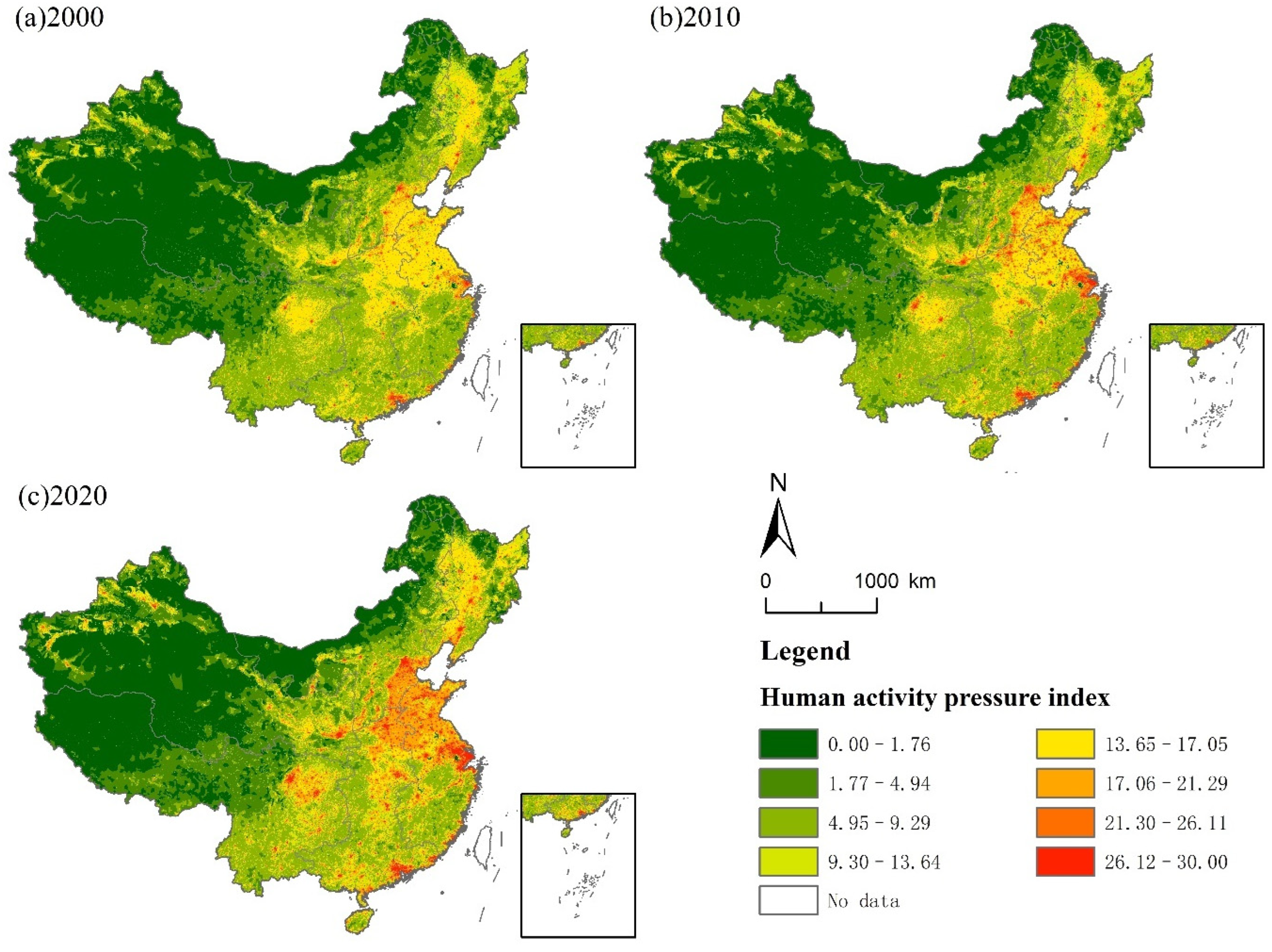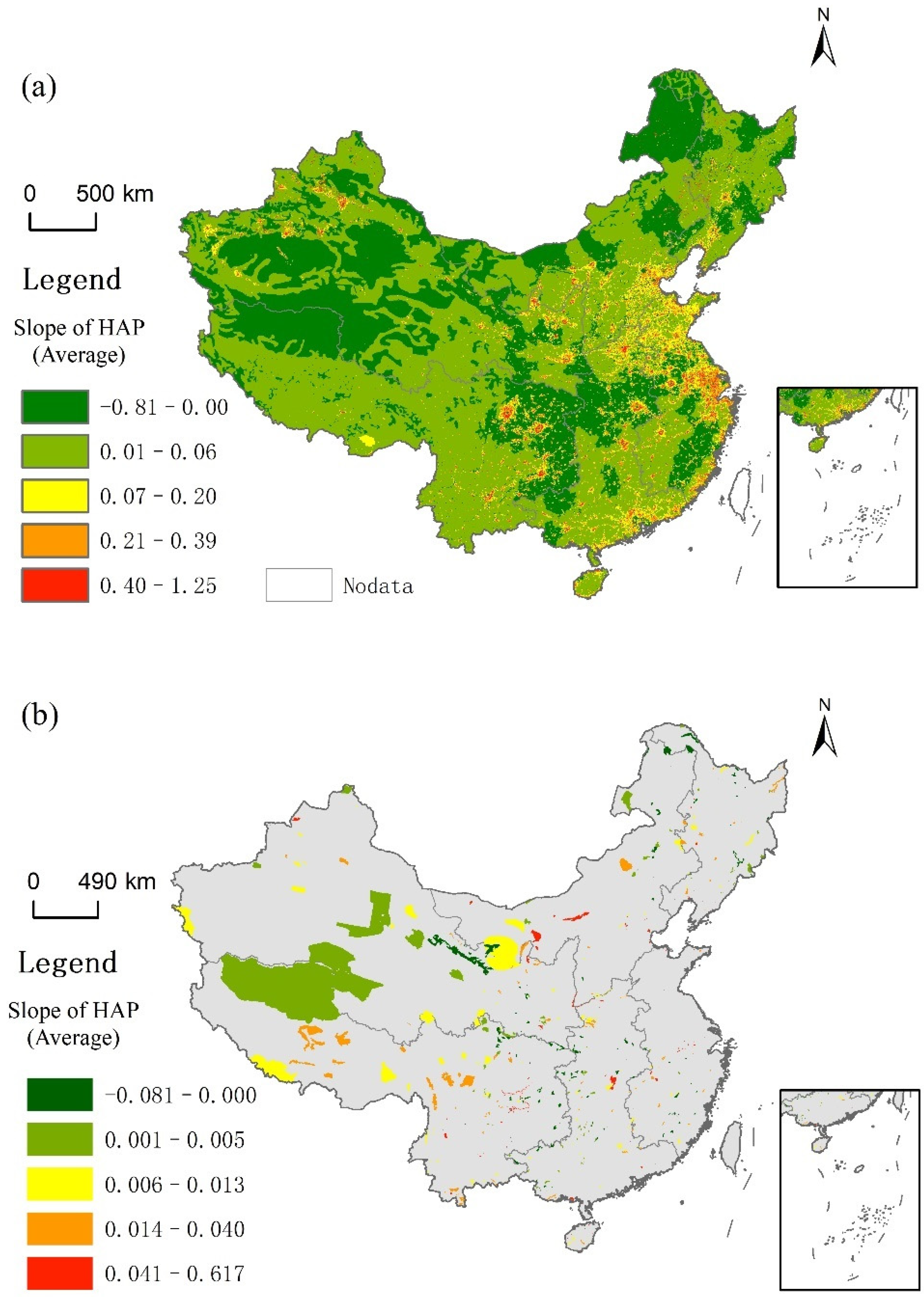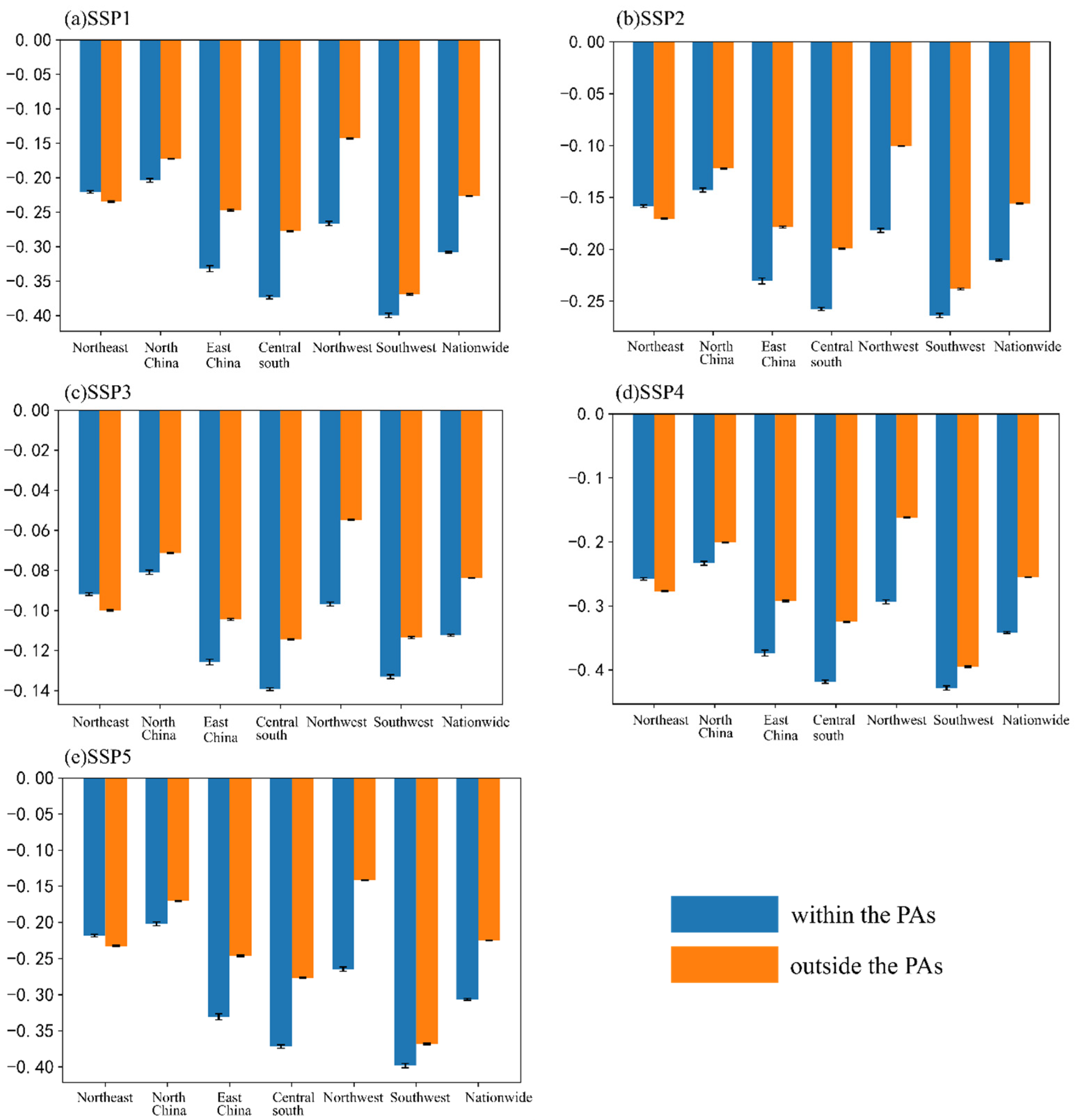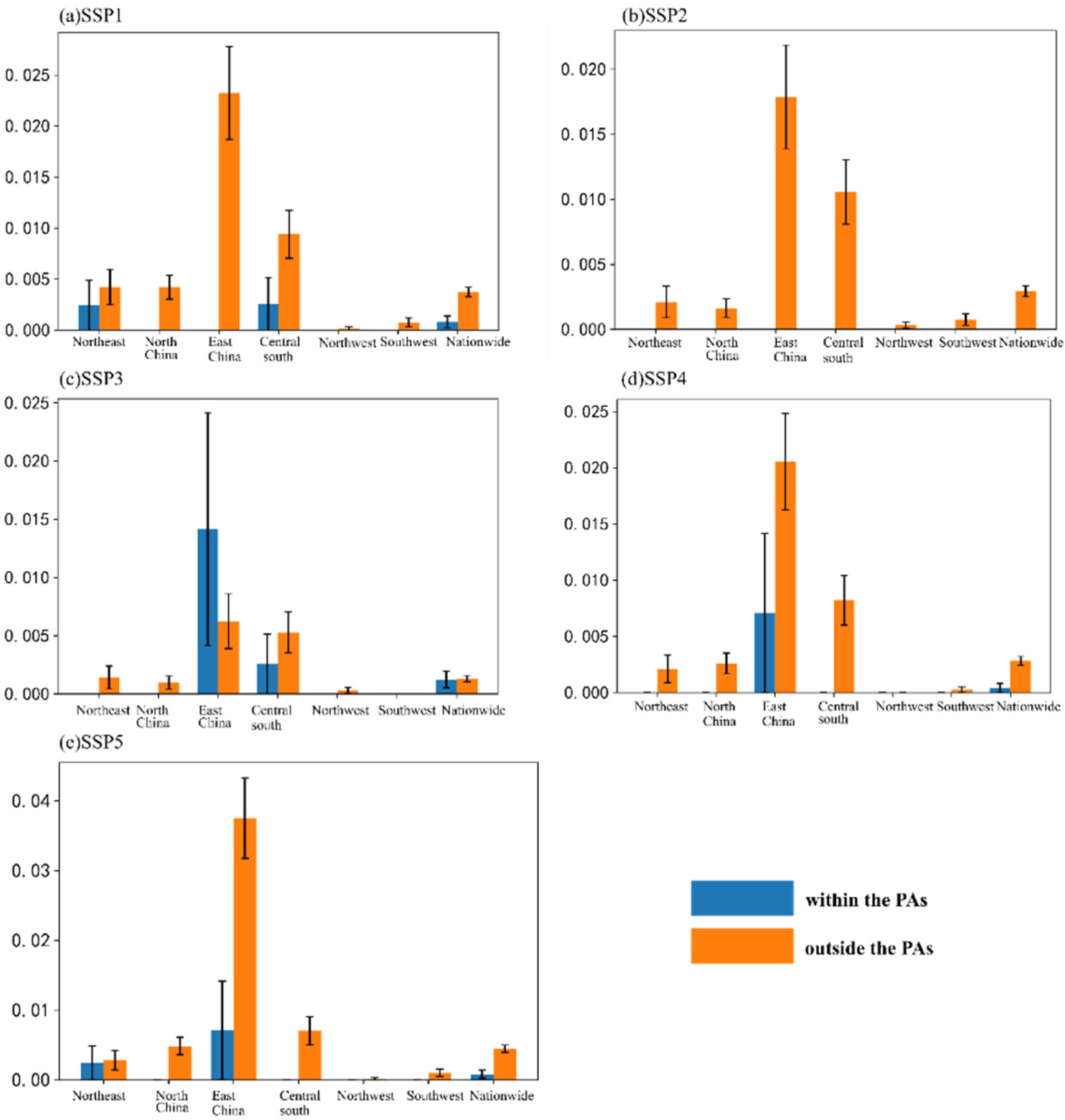Effectiveness of China’s Protected Areas in Mitigating Human Activity Pressure
Abstract
:1. Introduction
2. Literature Review
2.1. Human Pressure on PAs
2.2. A Review of Effectiveness Assessment of PAs
3. Materials and Methods
3.1. HAP Index
3.2. Propensity Score Matching Method
3.3. The Panel Model
3.4. Data Source and Processing
4. Results
4.1. Spatial Distribution of the HAP Index in China and Its PAs
4.1.1. Spatial Distribution of the HAP Index in China
4.1.2. Spatial Distribution of the HAP Index in PAs in China
4.2. Balance Test of the Propensity Score Matching Method
4.3. Assessment of China’s PAs regarding the Alleviation of the Pressure of Human Activities
4.4. Assessment of the HAP Mitigation of PAs in China under the SSP Scenarios
4.4.1. Population Pressure Mitigation of PAs in China under the SSP Scenarios
4.4.2. Urban Land Pressure Mitigation by PAs in China under the SSP Scenarios
5. Discussion
5.1. The Pressure of Human Activities in 75.15% of China’s PAs Shows an Upward Trend
5.2. Regional Differences in China’s PAs in Alleviating the Pressure of Human Activities
6. Conclusions
- (1)
- From 2000 to 2020, the pressure of human activities began to spread from the urban center to the surrounding areas. In total, 80.78% of China’s land is under pressure from human activities to varying degrees, while only 45.96 % of the protected land has a HAP index greater than 0. The land area with a rising trend of the HAP index accounts for 64.71% of the total area, and 75.15% of the reserves show an upward trend in the HAP index, but their area accounts for only 37.98% of the total area of PAs.
- (2)
- PAs in China can relieve the pressure of human activities by 1.37%, and there are regional differences in the ability of PAs to alleviate the pressure of human activities. The reserves in Northeast, East and Central China have the most significant effects on relieving the pressure of human activities, with coefficients of −0.339, −0.328 and −0.199, respectively. Meanwhile, PAs in Southwest and Northwest China are increasing the pressure of human activity.
- (3)
- Under the five SSP scenarios, the urban land pressure index shows an overall increasing trend, and the increase is mainly concentrated in Eastern and Central China, but there is no similar pattern under the five SSP scenarios. For example, under the SSP3 scenario, the average increase of urban land pressure in the Eastern China PAs exceeds that outside the PAs.
7. Implications
Author Contributions
Funding
Institutional Review Board Statement
Informed Consent Statement
Data Availability Statement
Conflicts of Interest
References
- Shi, H.; Li, X.; Liu, X.; Wang, S.; Liu, X.; Zhang, H.; Tang, D.; Li, T. Global protected areas boost the carbon sequestration capacity: Evidences from econometric causal analysis. Sci. Total Environ. 2020, 715, 137001. [Google Scholar] [CrossRef] [PubMed]
- Romanillos, T.; Maneja, R.; Varga, D.; Badiella, L.; Boada, M. Protected Natural Areas: In Sickness and in Health. Int. J. Environ. Res. Public Health 2018, 15, 2182. [Google Scholar] [CrossRef] [PubMed] [Green Version]
- Zhao, H.; Wu, R.; Long, Y.; Hu, J.; Yang, F.; Jin, T.; Wang, J.; Hu, P.; Wu, W.; Diao, Y.; et al. Individual-level performance of nature reserves in forest protection and the effects of management level and establishment age. Biol. Conserv. 2019, 233, 23–30. [Google Scholar] [CrossRef]
- Levin, N.; Ali, S.; Crandall, D.; Kark, S. World Heritage in danger: Big data and remote sensing can help protect sites in conflict zones. Glob. Environ. Chang. 2019, 55, 97–104. [Google Scholar] [CrossRef]
- Harris, N.C.; Mills, K.L.; Harissou, Y.; Hema, E.M.; Gnoumou, I.T.; Vanzoeren, J.; Abdel-Nasser, Y.I.; Doamba, B. First camera survey in Burkina Faso and Niger reveals human pressures on mammal communities within the largest protected area complex in West Africa. Conserv. Lett. 2019, 12, e12667. [Google Scholar] [CrossRef] [Green Version]
- Abukari, H.; Mwalyosi, R.B. Comparing pressures on national parks in Ghana and Tanzania: The case of Mole and Tarangire National Parks. Glob. Ecol. Conserv. 2018, 15, e00405. [Google Scholar] [CrossRef]
- Friedl, M.A.; Sulla-Menashe, D.; Tan, B.; Schneider, A.; Ramankutty, N.; Sibley, A.; Huang, X. MODIS Collection 5 global land cover: Algorithm refinements and characterization of new datasets. Remote Sens. Environ. 2010, 114, 168–182. [Google Scholar] [CrossRef]
- Montesino, P.F.; Toivonen, T.; Di, M.E.; Kukkala, A.S.; Kullberg, P.; Kuusterã¤, J.; Lehtomã¤Ki, J.; Tenkanen, H.; Verburg, P.H.; Moilanen, A. Global protected area expansion is compromised by projected land-use and parochialism. Nature 2014, 516, 383–386. [Google Scholar] [CrossRef] [PubMed] [Green Version]
- Hole, D.G.; Willis, S.G.; Pain, D.J.; Fishpool, L.D.; Butchart, S.H.M.; Collingham, Y.C.; Rahbek, C.; Huntley, B. Projected impacts of climate change on a continent-wide protected area network. Ecol. Lett. 2009, 12, 420–431. [Google Scholar] [CrossRef]
- Cincotta, R.P.; Wisnewski, J.; Engelman, R. Human population in the biodiversity hotspots. Nature 2000, 404, 990–992. [Google Scholar] [CrossRef] [PubMed]
- Gilbert, M.; Nicolas, G.; Cinardi, G.; Van Boeckel, T.P.; Vanwambeke, S.O.; Wint, G.R.W.; Robinson, T.P. Global distribution data for cattle, buffaloes, horses, sheep, goats, pigs, chickens and ducks in 2010. Sci. Data 2018, 5, 180227. [Google Scholar] [CrossRef] [Green Version]
- Virkkala, R.; Rajasärkkä, A. Preserving species populations in the boreal zone in a changing climate: Contrasting trends of bird species groups in a protected area network. Nat. Conserv. 2018, 3, 1–20. [Google Scholar] [CrossRef] [Green Version]
- Bennett, M.M.; Smith, L.C. Advances in using multitemporal night-time lights satellite imagery to detect, estimate, and monitor socioeconomic dynamics. Remote Sens. Environ. 2017, 192, 176–197. [Google Scholar] [CrossRef]
- Chen, Z.; Yu, B.; Yang, C.; Zhou, Y.; Yao, S.; Qian, X.; Wang, C.; Wu, B.; Wu, J. An extended time series (2000–2018) of global NPP-VIIRS-like nighttime light data from a cross-sensor calibration. Earth Syst. Sci. Data 2021, 13, 889–906. [Google Scholar] [CrossRef]
- Li, X.; Zhou, Y.; Zhao, M.; Zhao, X. A harmonized global nighttime light dataset 1992–2018. Sci. Data 2020, 7, 168. [Google Scholar] [CrossRef]
- Geldmann, J.; Joppa, L.N.; Burgess, N.D. Mapping Change in Human Pressure Globally on Land and within Protected Areas. Conserv. Biol. 2014, 28, 1604–1616. [Google Scholar] [CrossRef]
- Sanderson, E.W.; Jaiteh, M.; Levy, M.A.; Redford, K.H.; Wannebo, A.V.; Woolmer, G. The Human Footprint and the Last of the Wild. BioScience 2002, 52, 891–904. [Google Scholar] [CrossRef]
- Venter, O.; Sanderson, E.W.; Magrach, A.; Allan, J.R.; Beher, J.; Jones, K.R.; Possingham, H.P.; Laurance, W.F.; Wood, P.; Fekete, B.M.; et al. Global terrestrial Human Footprint maps for 1993 and 2009. Sci. Data 2016, 3, 160067. [Google Scholar] [CrossRef] [Green Version]
- Venter, O.; Sanderson, E.W.; Magrach, A.; Allan, J.R.; Beher, J.; Jones, K.R.; Possingham, H.P.; Laurance, W.F.; Wood, P.; Fekete, B.M.; et al. Sixteen years of change in the global terrestrial human footprint and implications for biodiversity conservation. Nat. Commun. 2016, 7, 12558. [Google Scholar] [CrossRef] [Green Version]
- Joppa, L.; Pfaff, A. Reassessing the forest impacts of protection. Ann. N. Y. Acad. Sci. 2010, 1185, 135–149. [Google Scholar] [CrossRef]
- Jones, K.R.; Venter, O.; Fuller, R.A.; Allan, J.R.; Maxwell, S.L.; Negret, P.J.; Watson, J.E.M. One-third of global protected land is under intense human pressure. Science 2018, 360, 788–791. [Google Scholar] [CrossRef] [Green Version]
- Wu, R.; Zhang, S.; Yu, D.W.; Zhao, P.; Li, X.; Wang, L.; Yu, Q.; Ma, J.; Chen, A.; Long, Y. Effectiveness of China’s nature reserves in representing ecological diversity. Front. Ecol. Environ. 2011, 9, 383–389. [Google Scholar] [CrossRef]
- Hellwig, N.; Walz, A.; Markovic, D. Climatic and socioeconomic effects on land cover changes across Europe: Does protected area designation matter? PLoS ONE 2019, 14, e0219374. [Google Scholar] [CrossRef] [PubMed] [Green Version]
- Guetté, A.; Godet, L.; Juigner, M.; Robin, M. Worldwide increase in Artificial Light At Night around protected areas and within biodiversity hotspots. Biol. Conserv. 2018, 223, 97–103. [Google Scholar] [CrossRef]
- Durán, A.P.; Rauch, J.; Gaston, K.J. Global spatial coincidence between protected areas and metal mining activities. Biol. Conserv. 2013, 160, 272–278. [Google Scholar] [CrossRef]
- Radeloff, V.C.; Stewart, S.I.; Hawbaker, T.J.; Gimmi, U.; Pidgeon, A.M.; Flather, C.H.; Hammer, R.B.; Helmers, D.P. Housing growth in and near United States protected areas limits their conservation value. Proc. Natl. Acad. Sci. USA 2010, 107, 940–945. [Google Scholar] [CrossRef] [PubMed] [Green Version]
- Qiu, C.; Hu, J.; Yang, F.; Liu, F.; Li, X. Human Pressures on Natural Reserves in Yunnan Province and Management Implications. Sci. Rep. 2018, 8, 3260. [Google Scholar] [CrossRef]
- Wang, H.; Lü, Z.; Gu, L.; Wen, C. Observations of China’s forest change (2000-2013) based on Global Forest Watch dataset. Biodiv. Sci. 2015, 23, 575–582. [Google Scholar] [CrossRef]
- Zeng, H.; Sui, D.Z.; Wu, X.B. Human disturbances on landscapes in protected areas: A case study of the Wolong Nature Reserve. Ecol. Res. 2005, 20, 487–496. [Google Scholar] [CrossRef]
- Joppa, L.N.; Pfaff, A. High and Far: Biases in the Location of Protected Areas. PLoS ONE 2009, 4, e8273. [Google Scholar] [CrossRef]
- Zhao, G.; Tian, Y.; Tang, Z.; Li, J.; Hui, Z. Distribution of terrestrial national nature reserves in relation to human activities and natural environments in China. Biodivers. Sci. 2013, 21, 658–665. [Google Scholar]
- Andam, K.S.; Ferraro, P.J.; Pfaff, A.; Sanchez-Azofeifa, G.A.; Robalino, J.A. Measuring the effectiveness of protected area networks in reducing deforestation. Proc. Natl. Acad. Sci. USA 2008, 105, 16089–16094. [Google Scholar] [CrossRef] [PubMed] [Green Version]
- Bowker, J.N.; De Vos, A.; Ament, J.M.; Cumming, G.S. Effectiveness of Africa’s tropical protected areas for maintaining forest cover. Conserv. Biol. 2017, 31, 559–569. [Google Scholar] [CrossRef]
- Nolte, C.; Agrawal, A.; Silvius, K.M.; Soares-Filho, B.S. Governance regime and location influence avoided deforestation success of protected areas in the Brazilian Amazon. Proc. Natl. Acad. Sci. USA 2013, 110, 4956–4961. [Google Scholar] [CrossRef] [PubMed] [Green Version]
- Geldmann, J.; Manica, A.; Burgess, N.D.; Coad, L.; Balmford, A. A global-level assessment of the effectiveness of protected areas at resisting anthropogenic pressures. Proc. Natl. Acad. Sci. USA 2019, 116, 23209–23215. [Google Scholar] [CrossRef]
- Shi, H.; Li, T.; Ma, Z.; Zhang, H.; Liu, X.; Chen, N. What influence do regional government officials’ have on tourism related growth?: Evidence from China. Curr. Issues Tour. 2021, 1–13. [Google Scholar] [CrossRef]
- Zhang, H.; Li, X.; Liu, X.; Chen, Y.; Ou, J.; Niu, N.; Jin, Y.; Shi, H. Will the development of high speed railway have impacts on land use change patterns in China? Ann. Am. Assoc. Geogr. 2019, 109, 979–1005. [Google Scholar] [CrossRef]
- Zhang, Z.; Tang, Y.; Pan, H.; Yao, C.; Zhang, T. Assessment of the Ecological Protection Effectiveness of Protected Areas Using Propensity Score Matching: A Case Study in Sichuan, China. Int. J. Environ. Res. Public Health 2022, 19, 4920. [Google Scholar] [CrossRef]
- Rosenbaum, P.R.; Rubin, D.B. The central role of the propensity score in observational studies for causal effects. Biometrika 1983, 70, 41–55. [Google Scholar] [CrossRef]
- Balmford, A.; Beresford, J.; Green, J.; Naidoo, R.; Walpole, M.; Manica, A.; Reid, W.V. A Global Perspective on Trends in Nature-Based Tourism. PLoS Biol. 2009, 7, e1000144. [Google Scholar] [CrossRef] [Green Version]
- Fuller, R.A.; McDonald-Madden, E.; Wilson, K.A.; Carwardine, J.; Grantham, H.S.; Watson, J.E.M.; Klein, C.J.; Green, D.C.; Possingham, H.P. Replacing underperforming protected areas achieves better conservation outcomes. Nature 2010, 466, 365–367. [Google Scholar] [CrossRef] [PubMed]
- Jiricka-Pürrer, A.; Tadini, V.; Salak, B.; Taczanowska, K.; Tucki, A.; Senes, G. Do Protected Areas Contribute to Health and Well-Being? A Cross-Cultural Comparison. Int. J. Environ. Res. Public Health 2019, 16, 1172. [Google Scholar] [CrossRef] [PubMed] [Green Version]
- Yang, Y.; Nan, Y.; Liu, Z.; Zhang, D.; Sun, Y. Direct and indirect losses of natural habitat caused by future urban expansion in the transnational area of Changbai Mountain. Sustain. Cities Soc. 2020, 63, 102487. [Google Scholar] [CrossRef]
- Cao, W.; Huang, L.; Xiao, T.; Wu, D. Effects of human activities on the ecosystems of China’s National Nature Reserves. Acta Ecol. Sin. 2019, 39, 1338–1350. [Google Scholar]




| Data Category | Nature | Year | Data Source |
|---|---|---|---|
| Data of PAs | |||
| Boundary data of PAs in China | Vector data | 1957–2012 | Geographic Information Database of China Nature Reserve Specimen Resource Sharing Platform http://www.papc.cn/html/folder/946895-1.htm (accessed on 20 May 2019) |
| List of National Nature Reserves (2017) | Text data | 2017 | Ministry of Ecology and Environment of the People’s Republic of China. http://www.mee.gov.cn/ (accessed on 20 May 2019) |
| Data used to construct HAP index | |||
| Land cover data | Raster data (300 m) | 2000–2019 | European Space Agency, http://maps.elie.ucl.ac.be/CCI/viewer/index.php (accessed on 20 May 2019) |
| Future urban land use data | Raster data (300 m) | 2020–2050 | https://doi.pangaea.de/10.1594/PANGAEA.905890 (accessed on 4 July 2020) |
| Population density data | Raster data (1 km) | 2000–2020 | NASA Center for Socio-Economic Data and Applications. https://sedac.ciesin.columbia.edu/data/set/gpw-v4-population-density-rev11 (accessed on 4 July 2020) |
| Future population data | Raster data (1 km) | 2020–2050 | NASA Center for Socio-Economic Data and Applications. https://sedac.ciesin.columbia.edu/data/set/popdynamics-1-km-downscaled-pop-base-year-projection-ssp-2000-2100-rev01 (accessed on 4 July 2020) |
| Complementary DMSP and VIIRS night light data | Raster data (1 km) | 2000–2018 | https://figshare.com/articles/dataset/Harmonization_of_DMSP_and_VIIRS_nighttime_light_data_from_1992-2018_at_the_global_scale/9828827/2 (accessed on 4 July 2020) |
| Other data | |||
| Temperature | Text data | 2000–2020 | NOAA National Environmental Information Center Database https://www.ncei.noaa.gov/data/global-summary-of-the-day/archive/ (accessed on 4 July 2020) |
| Precipitation | Text data | 2000–2020 | NOAA National Environmental Information Center Database https://www.ncei.noaa.gov/data/global-summary-of-the-day/archive/ (accessed on 4 July 2020) |
| Elevation | Raster data (1 km) | Food and Agriculture Organization of the United Nations http://www.fao.org/soils-portal/soil-survey/soil-maps-and-databases/harmonized-world-soil-database-v12/zh/ (accessed on 4 July 2020) | |
| Data set of major roads across the country | Vector data | 2000 | Geographic Data Platform of Peking University https://geodata.pku.edu.cn/index.php?c=content&a=show&id=1399 (accessed on 4 July 2020) |
| National road data sets | Vector data | 2018 | Geographic Data Platform of Peking University. https://geodata.pku.edu.cn/index.php?c=content&a=show&id=713 (accessed on 4 July 2020) |
| Land area data | Raster data (1 km) | 2010 | NASA Center for Socio-Economic Data and Applications. https://sedac.ciesin.columbia.edu/data/set/gpw-v4-land-water-area-rev11 (accessed on 4 July 2020) |
| Variable | Mean Value | Standard Deviation (%) | Reduction in the Standard Deviation (%) | t-Test | |||
|---|---|---|---|---|---|---|---|
| The Treatment Group | The Control Group | t Statistic | Associated Probability of the t-Test | ||||
| lnpecp | Before the match | −2.7261 | −3.1 | 42.1 | 52.90 | 0.000 | |
| After the match | −2.7261 | −2.7284 | 0.3 | 99.4 | 0.26 | 0.796 | |
| lntemp | Before the match | 3.8746 | 3.8061 | 26.9 | 34.26 | 0.000 | |
| After the match | 3.8746 | 3.8794 | −1.9 | 92.9 | −1.91 | 0.056 | |
| lnslope | Before the match | 0.7148 | 0.21309 | 27.6 | 37.80 | 0.000 | |
| After the match | 0.7148 | 0.70359 | 0.6 | 97.8 | 0.63 | 0.528 | |
| lnelev | Before the match | 6.7748 | 6.7164 | 4.0 | 5.14 | 0.000 | |
| After the match | 6.7748 | 6.7708 | 0.3 | 93.2 | 0.28 | 0.781 | |
| lntourban | Before the match | 10.333 | 10.392 | −5.5 | −6.58 | 0.000 | |
| After the match | 10.333 | 10.321 | 1.1 | 80.5 | 1.08 | 0.279 | |
| lntoroad | Before the match | 9.9819 | 10.026 | −3.7 | −4.56 | 0.000 | |
| After the match | 9.9819 | 9.9951 | −1.1 | 70.4 | −1.11 | 0.265 | |
| lnlandcover | Before the match | 0.80104 | 0.8439 | −7.1 | −8.70 | 0.000 | |
| After the match | 0.80104 | 0.80166 | −0.1 | 98.6 | −0.11 | 0.913 | |
| Variable | (1) | (2) | (3) | (4) | (5) | (6) | (7) |
|---|---|---|---|---|---|---|---|
| Nationwide | Northeast China | North China | East China | Central South Region | Northwest China | Southwest China | |
| PAS | −0.0137 * | −0.339 *** | −0.0388 * | −0.328 *** | −0.199 *** | 0.0465 ** | 0.0482 *** |
| (0.0070) | (0.0158) | (0.0206) | (0.0106) | (0.0062) | (0.0202) | (0.0112) | |
| lnelev | −0.491 *** | −0.279 *** | −0.616 *** | −0.140 *** | −0.141 *** | −0.797 *** | −0.911 *** |
| (0.0018) | (0.0080) | (0.0056) | (0.0032) | (0.0029) | (0.0091) | (0.0045) | |
| lnslope | 0.112 *** | −0.0825 *** | 0.216 *** | −0.0651 *** | −0.0873 *** | 0.109 *** | 0.0832 *** |
| (0.0016) | (0.0044) | (0.0043) | (0.0025) | (0.0020) | (0.0039) | (0.0033) | |
| lnpecp | 0.0635 *** | 0.00874 *** | 0.0460 *** | −0.00984 *** | −0.0240 *** | 0.102 *** | 0.0202 *** |
| (0.0004) | (0.0014) | (0.0009) | (0.0016) | (0.0009) | (0.0007) | (0.0011) | |
| lntemp | 0.319 *** | 0.140 *** | 0.0735 *** | 0.675 *** | 0.222 *** | 0.533 *** | 0.366 *** |
| (0.0018) | (0.0074) | (0.0041) | (0.0088) | (0.0048) | (0.0058) | (0.0023) | |
| _cons | 3.577 *** | 2.952 *** | 5.138 *** | 0.202 *** | 2.072 *** | 5.138 *** | 6.736 *** |
| (0.0142) | (0.0549) | (0.0414) | (0.0401) | (0.0261) | (0.0735) | (0.0358) | |
| N | 807292 | 79403 | 138076 | 82089 | 111441 | 195871 | 200343 |
| R2 | 0.4122 | 0.2150 | 0.2584 | 0.4839 | 0.4793 | 0.2188 | 0.5306 |
| SSPs Scenario | Number of PAs | Index (Negative, %) | Index (Positive, %) | Relative Validity (Average) |
|---|---|---|---|---|
| SSP1 | 670 | 74.03 | 25.97 | −0.076 |
| SSP2 | 670 | 76.72 | 23.28 | −0.054 |
| SSP3 | 670 | 79.55 | 20.46 | −0.031 |
| SSP4 | 670 | 76.12 | 23.88 | −0.087 |
| SSP5 | 670 | 74.03 | 25.97 | −0.076 |
| SSPs Scenario | Number of PAs | Index (Negative, %) | Index (Positive, %) | Relative Validity (Average) |
|---|---|---|---|---|
| SSP1 | 670 | 94.63 | 5.37 | 0.032 |
| SSP2 | 670 | 95.37 | 4.63 | 0.022 |
| SSP3 | 670 | 95.67 | 4.33 | 0.016 |
| SSP4 | 670 | 94.93 | 5.07 | 0.028 |
| SSP5 | 670 | 93.88 | 6.12 | 0.031 |
Publisher’s Note: MDPI stays neutral with regard to jurisdictional claims in published maps and institutional affiliations. |
© 2022 by the authors. Licensee MDPI, Basel, Switzerland. This article is an open access article distributed under the terms and conditions of the Creative Commons Attribution (CC BY) license (https://creativecommons.org/licenses/by/4.0/).
Share and Cite
Chen, J.; Shi, H.; Wang, X.; Zhang, Y.; Zhang, Z. Effectiveness of China’s Protected Areas in Mitigating Human Activity Pressure. Int. J. Environ. Res. Public Health 2022, 19, 9335. https://doi.org/10.3390/ijerph19159335
Chen J, Shi H, Wang X, Zhang Y, Zhang Z. Effectiveness of China’s Protected Areas in Mitigating Human Activity Pressure. International Journal of Environmental Research and Public Health. 2022; 19(15):9335. https://doi.org/10.3390/ijerph19159335
Chicago/Turabian StyleChen, Jian, Hong Shi, Xin Wang, Yiduo Zhang, and Zihan Zhang. 2022. "Effectiveness of China’s Protected Areas in Mitigating Human Activity Pressure" International Journal of Environmental Research and Public Health 19, no. 15: 9335. https://doi.org/10.3390/ijerph19159335
APA StyleChen, J., Shi, H., Wang, X., Zhang, Y., & Zhang, Z. (2022). Effectiveness of China’s Protected Areas in Mitigating Human Activity Pressure. International Journal of Environmental Research and Public Health, 19(15), 9335. https://doi.org/10.3390/ijerph19159335






